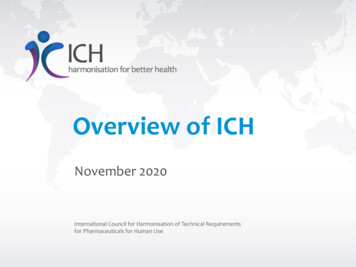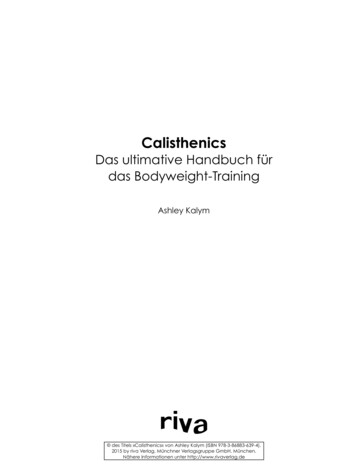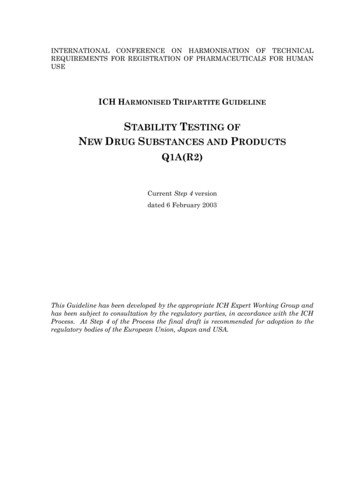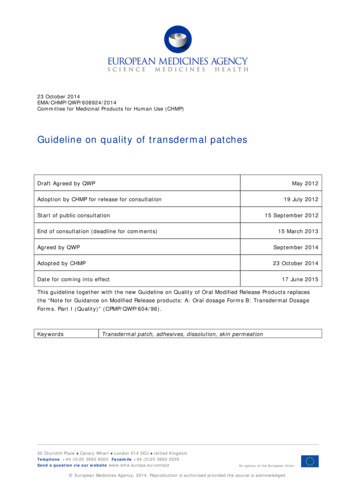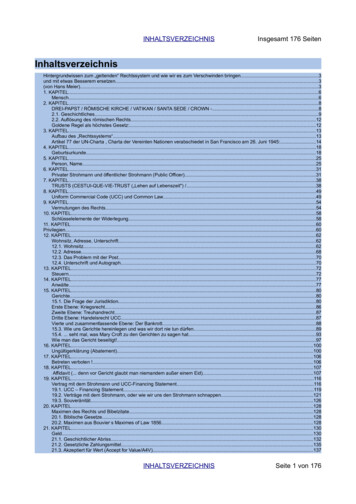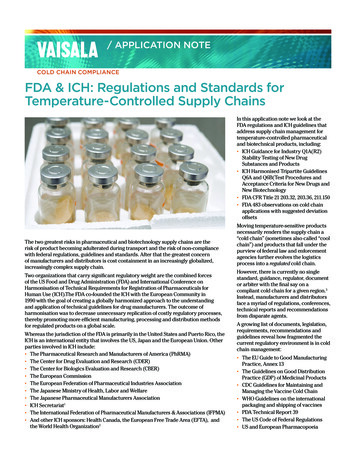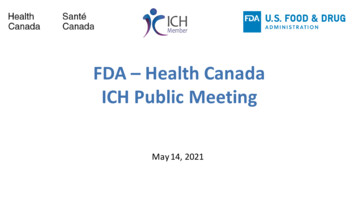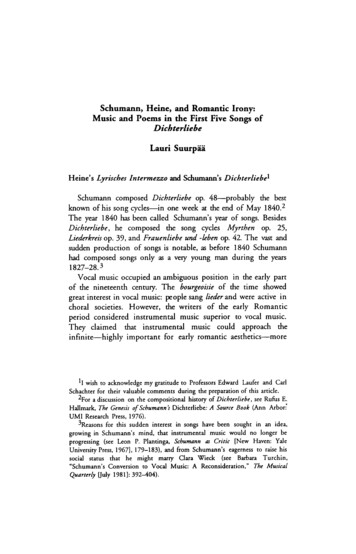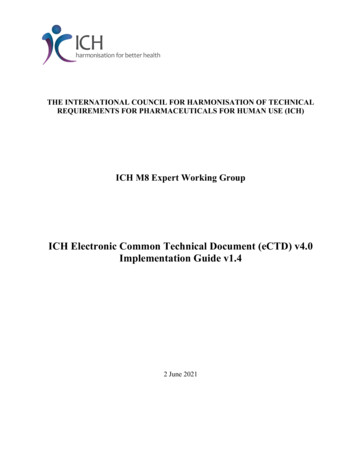
Transcription
THE INTERNATIONAL COUNCIL FOR HARMONISATION OF TECHNICALREQUIREMENTS FOR PHARMACEUTICALS FOR HUMAN USE (ICH)ICH M8 Expert Working GroupICH Electronic Common Technical Document (eCTD) v4.0Implementation Guide v1.42 June 2021
DOCUMENT CHANGE HISTORYVersion1.01.1Date10 December 201520 January 20161.210 November 20161.35 June 20181.42 June 2021CommentsInitial Step 4 document.Minor editorial corrections after Step 4 approval andsign-off.Revisions based on M8 Review and the followingchange requests: 00070, 00080, 00090, 00110, 00120,00150, 00170, 00180, 00220, 00230, 00270, 00300,00330, 00440, 00450, and 00460. Revised referencesrelated to “document groups” to now reference “contextgroups” (see Common Abbreviations and Terms).Revisions to the eCTD v4.0 Implementation Guideinclude the following change requests: Cardinality ofData Elements (00520), Validation Rules (00530,00560), Document element changes, Document Label(00550), Study Group Order (00540), and additional M8discussion topics (e.g., change in delimiter used forStudyID Study Title keyword value, and generalguidance for sender-defined keywords).Revisions to the eCTD v4.0 Implementation Guideinclude the following change requests: additionalvalidation rules (00580, 00590 and 00620) and removalof media type examples (00600).i
Legal notice: This document is protected by copyright and may, with the exception of the ICH logo, beused, reproduced, incorporated into other works, adapted, modified, translated or distributed under apublic license provided that ICH's copyright in the document is acknowledged at all times. In case ofany adaption, modification or translation of the document, reasonable steps must be taken to clearlylabel, demarcate or otherwise identify that changes were made to or based on the original document.Any impression that the adaption, modification or translation of the original document is endorsed orsponsored by the ICH must be avoided.The document is provided "as is" without warranty of any kind. In no event shall the ICH or the authorsof the original document be liable for any claim, damages or other liability arising from the use of thedocument.The above-mentioned permissions do not apply to content supplied by third parties. Therefore, fordocuments where the copyright vests in a third party, permission for reproduction must be obtained fromthis copyright holder.ii
TABLE OF CONTENTSPageNotice to Readers . viiiInstructions to Reader. ixDocument Content . ixCommon Abbreviations and Terms . xXML Snippets. xiiLocation in XML .xiii1.Purpose . 12.Scope . 1Business Case. 13.Background . 2General Background and eCTD History . 2Implementation Experience in ICH Regions and Observer Countries . 2Canada. 2European Union . 2Japan . 3Switzerland . 3United States . 33.2.13.2.23.2.33.2.43.2.5The Framework for the ICH eCTD v4.0 . 4Advantages of eCTD v4.0 . 5Change Control . 64.Components of the eCTD v4.0 . 7Files and Folders . 8Controlled Vocabularies. 8ICH eCTD v4.0 XML Schema . 9The eCTD v4.0 XML Message . 9OIDs and UUIDs . 94.5.1 Object Identifiers . 104.5.2 Universally Unique Identifiers . 10Data Types . 10Regional/Module 1 Implementation Guides . 114.7.1 Region-Specific Elements . 114.7.2 ICH Excluded Elements. 12Excluded Business Processes. 125.Submission Contents, Folder and File Structure . 13iii
Submission Unit Contents . 13Naming Conventions. 145.2.1 Allowable Characters . 145.2.2 Length . 15Pathname Conventions and Best Practices. 15Folder Hierarchy . 15File Formats . 16Checksums . 16Compressed Archive . 166.Controlled Vocabularies . 16Controlled Vocabularies specified by ICH . 16Controlled Vocabularies specified Regionally. 17Controlled Vocabulary specified by HL7 . 19Controlled Vocabulary specified by External Organisations . 20Sender-defined Values . 206.5.1 Keyword Definitions. 207.ICH eCTD v4.0 XML Schema . 21Core Schema . 21InfrastructureRoot-r2 . 21iso-21090hl7-r2 datatypes. 21Voc-r2 . 217.1.17.1.27.1.3eCTD v 4.0 Schema . 217.2.1 eCTD v 4.0 Interaction Schema . 217.2.2 eCTD v4.0 Payload Schema . 228.eCTD v4.0 XML Message . 22Message Header . 228.1.1 Sample XML. 228.1.2 Required Elements . 23Payload Message . 248.2.1 Concepts represented in the Payload Message . 248.2.2 General Payload Considerations . 258.2.3 XML Message Structure . 258.2.4 Submission Unit . 318.2.5 Priority Number for Context of Use . 358.2.6 Context of Use . 388.2.7 Related Context of Use (Context of Use Life Cycle) . 438.2.8 Document Reference . 448.2.9 Context of Use Keyword . 46iv
2.189.10.Considerations for Keywords . 48XML SAMPLES: Context of Use . 48Sequence Number . 56XML SAMPLES: Submission Unit . 58Application. 59Document . 63Approaches to Changes in Context Groups . 71Considerations for the Document Element . 77Keyword Definition . 82Dossier Management . 91Transition Mapping Message From eCTD v3.2.2 . 92Overview of the Transition Mapping Message . 92Schema . 95Submission Package . 95Message Header . 9510.4.1Required Elements and Attributes . 9610.4.2XML Sample. 96Payload Message . 9710.5.1Concepts represented in the TMM Payload Message . 9710.5.2General Payload Considerations . 9810.5.3TMM XML Message Structure . 9910.5.4Submission Unit . 10510.5.5Priority Number for Context of Use . 10610.5.6Context of Use . 10710.5.7Document Reference . 11010.5.8Context of Use Keyword . 11110.5.9XML SAMPLE: Transition mapping of Context of Use Elements and Keywords . 11210.5.10 Context of Use with Study Information . 11310.5.11 Sequence Number . 11710.5.12 Submission . 11910.5.13 Technical Contact . 12010.5.14 Application. 12510.5.15 Applicant . 12710.5.16 XML Sample: Application and Applicant . 12910.5.17 Document . 12910.5.18 Keyword Definition . 13210.5.19 XML SAMPLE: Transition mapping of Keyword Definitions . 13510.5.20 XML SAMPLE: Transition mapping of Study-Id and Title. 13511.Appendix 1: Sample Files and Folders for Modules 2 – 5 . 136Module 2 Summaries . 136Module 3 Quality. 136v
Module 4 Nonclinical Study Reports. 137Module 5 Clinical Study Reports . 13712.Appendix 2: Validation of the eCTD v4.0 Message . 139Summary of Validation Rules . 139Message Validation Rules. 142Submission Package Validation Rules . 15013.Appendix 3: Transition Mapping Message Validation Rules . 153Summary of Validation Rules . 153Message Validation Rules. 155Submission Package Validation Rules . 163LIST OF FIGURESFigure 1: Submission Unit Folder Structure .13Figure 2: Sample Folder Hierarchy of Module 3 .15Figure 3: Conceptual Model of Elements .24Figure 4: Context Group Model.71Figure 5: Transition Mapping Message Process .93Figure 6: Folder Structure for Transition Mapping Message .95Figure 7: Elements in the Transition Mapping Message .97Figure 8: Leaf in index.xml file .113Figure 9: v3.2.2 Elements and file-tags .113Figure 10: v3.2.2 Property element.114Figure 11: Updated study tagging file .116Figure 12: Module 2 Folder Structure .136Figure 13: Module 3 Folder Structure .136Figure 14: Module 4 Folder Structure .137Figure 15: Example of Study folders .137Figure 16: Module 5 Folder Structure .138Figure 17: Example of Study Folders .138LIST OF TABLESTable 1: Legend of Symbols used in Document . ixTable 2: Legend for XML Snippets . xiiTable 3: Location in XML Notation . xiiiTable 4: Sample XML Element Table . xivTable 5: Allowable Special Characters .14Table 6: Message Header XML Structure .22Table 7: v4.0 XML Message Structure .26Table 8: TMM Message Header XML Structure.95vi
Table 9: TMM XML Message Structure .100Table 10: TMM Attribute Mappings .115vii
NOTICE TO READERSSections of this document referencing the Health Level Seven (HL7) Version 3 Standard, RegulatoryProduct Submission Release 2 Normative are used with the publisher's permission. The HL7 Version 3Standard Regulatory Product Submission Release 2 Normative is copyrighted by Health Level SevenInternational ALL RIGHTS RESERVED.viii
INSTRUCTIONS TO READERThis is a technical document that provides instructions on how to implement the Electronic CommonTechnical Document (eCTD) v4.0 specification. The content is provided in a consistent manner withinthe document. In addition, the reader may be prompted by visual cues about the context or referencedinformation being presented in the document.Document ContentIn the document, there are several notations that are used to provide clarity to the subject matter. Thefirst is the use of Extensible Markup Language (XML) components (i.e., elements and attributes) versusthe concept that it represents. The document text will follow the notations described below: XML componentso The document’s narrative text is bold, italicised text in camel case, e.g., contextOfUseo The XML samples are as notated below in the XML Snippets section.Concepts without attribution to the standard and/or messageo A defined concept, e.g., Context of Use is noted in plain text with first letter capitalised.The following table provides visual cues that are used in the document.Table 1: Legend of Symbols used in DocumentIconDescriptionTechnical descriptionsItems to be careful to followAdditional InstructionsReferences to other documentsix
Common Abbreviations and TermsThe following table defines some abbreviations and common terms in this document and specific toeCTD v4.0.Abbreviation/TermDefinitionCENEuropean Committee for StandardizationClassClass is used in this document to qualify a base level element fromthe HL7 standard.Context GroupDefines the context of a group of documents with the same Contextof Use code and Keyword code combination.Previously known as "Document Group" in eCTD v4.0Implementation Guide version 1.1.Context of Use code andKeyword codecombinationThe combination includes both the code and code system for theContext of Use and Keyword in order to define the specific contextgroup under which the documents are grouped.Controlled vocabularyA controlled vocabulary is an established list of standardisedterminology for use in indexing and retrieval of information. 1DatatypeDatatype is used in this document to qualify elements andattributes that come from a datatype in the HL7 standard.DocumentDocument is used in this document to identify a content filerepresenting a document required or provided to be submitted. Inthe eCTD v4.0 message a document will be represented by adocument element referencing the file location and providing atitle. The document element will be presented in its context of use.Since a document can be used multiple times, adocumentReference element allows a document to be specified forthe contextOfUse. Each time the document is used in the samesubmission unit, that document may have a differentcontextOfUse. The relationship is provided via thedocumentReference element. Accordingly, each Context of Usemust reference a document.Document LabelAn abbreviated name for the document that may be assigned foreach context of use.eCTDElectronic Common Technical DocumentESTRIElectronic Standards for the Transfer of Regulatory InformationContent may be found at: http://estri.ich.org/1Refer to ICH M2 Glossary of Terms and Abbreviations (http://estri.ich.org/recommendations/)x
Abbreviation/TermDefinitionEWGExpert Working GroupGrouped SubmissionA grouped submission is defined as a regulatory activity thatimpacts multiple dossiers, based on regulatory requirements.Implementation of grouped submission functionality may varyregion to region.Group TitleA sender-defined keyword that may be used to further organisecontent under a context group.HL7Health Level 7 – International Health Data Standards DevelopmentOrganisationICHThe International Council for Harmonisation of TechnicalRequirements for Pharmaceuticals for Human UseISOInternational Organization for StandardizationIWGImplementation Working GroupOIDObject IdentifiersPayloadThe payload schema is the eCTD v4.0 base and it contains theelements in eCTD v4.0, including items from the Common ProductModel and Common Message Element schema. It is organised withthe following three elements in the structure: submissionUnit,submission and application.RPSRegulated Product Submission – HL7 standardSDOStandards Development OrganisationSTFStudy Tagging FileTMMTransition Mapping MessageURIUniform Resource IdentifierUUIDUniversally Unique IdentifiersXMLExtensible Markup Languagexi
XML SnippetsThe following table indicates the color coding used in the XML snippets and any meaning that shouldbe inferred in the samples.Table 2: Legend for XML BlackSchema components ?xml version "1.0" encoding "UTF-8"? XML notations . "" XML elementidcodeXML attributerootextensionValue of the attribute or element2.16.840.1.113883The following rules were used in the development of the XML samples: The notation of !--.notes .-- was used to describe conditions that should be met for anelement The notation [Description] was used to indicate when there were additional elements notrepresented in the XML, but may be present in the actual XML message.Note: XML editors may display these XML components differently, please use the legend abovefor XML presented in this document.xii
Location in XMLEach of the elements in this document includes a section named, "Location in XML". The notationincluded uses the following convention:Table 3: Location in XML NotationNotation DescriptionInstruction for use Single arrowThe element follows the previous withoutindentation in the XML. Double arrowThe element follows the previous with anindentation in the XML.For example, the following location shows both notations and is followed by the XML sample. controlActProcess subject submissionUnit component priorityNumber contextOfUseElement’s location in XML controlActProcess classCode "ACTN" moodCode "EVN" subject typeCode "SUBJ" submissionUnit id root "e6f34476-8288-43f2-a2ea-5860d19fcf32"/ code code "regional sub unit 1" codeSystem "2.16.840.1.113883.3.989.x.x.x"/ title value "Original Application- Indication: pain"/ statusCode code "active"/ component priorityNumber value "1000"/ contextOfUse Refer to XML Color Legend for color usage.Note: The priority number is represented in the path as it is a required element. In some cases optionalelements will not appear in this notation. The schema will enforce any element sequencingrequirements, but not optional elements. For ICH specific required elements, refer to Section 8.2 ofthis document.xiii
XML Elements TablesA table has been provided for each element in the XML message. When elements have multiple elementparts or attributes, they are provided in one table. When there are no attributes or values for an element,the cell is grayed out to indicate that an attribute value is not required in the XML message.Table 4: Sample XML Element TableTable Name: element . element 2 DescriptionInstructionsConformanceBusiness RulesExcluded Elementsand/or AttributesTable Name: Each table is named for the elements it is representing in the XML – i.e., element . element 2 . For example, the application element has an element for the identifier, itwould be represented as: application.idElement: Identifies the XML elementAttribute: Identifies the XML attributeCardinality: Provides information on how many times the element/attribute can be repeated in the XMLmessage. The values in this table define the cardinality to be applied in eCTD v4.0 implementation,which sometimes restrict the cardinality defined in the schema.Value(s) Allowed/Examples: Identifies the values allowed using simple data types and any associatedexamples. References to controlled vocabulary will also be provided.Description/Instructions: Provides a description of the element or attributeConformance: Identifies the validation requirements (e.g., XML Elements or attributes) and/orconditions that need to be met by the element.Business Rules: Identifies any business rules that are harmonised for ICH and refere
ICH Electronic Common Technical Document (eCTD) v4.0 . Implementation Guide v1.4. 2 June 2021 . i . DOCUMENT CHANGE HISTORY. Version Date Comments 1.0 10 December 2015 Initial Step 4 document. 1.1 20 January 2016 Minor editorial corrections after Step 4 approval and . TABLE OF CONTENTS Page Notice to Readers
